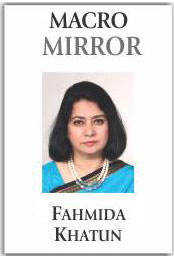Published in The Daily Star on Monday, 27 April 2015.
MACRO MIRROR
How happy are we?
Dr Fahmida Khatun
LAST week the World Happiness Report 2015 was launched in New York. The report shows that Switzerland is the happiest country in the world followed by Iceland, Denmark, Norway and Canada. Where does Bangladesh stand? We are 109th in the ranking among 158 countries which were surveyed. Before discussing why our position is low and what that implies, let us try to understand what such happiness indicators want to tell us.
The underlying reason for carrying out such studies is that material accumulation cannot bring happiness in human life. One has to look at the personal mental and physical wellbeing. True, one needs income to buy food, to live in a house, to have safe water and sanitation, to access education and health facilities and to save for future uncertain periods.
Money is a necessity. But how much money does one need to be happy? For an impoverished family a small sum of money makes a huge difference in their lives. They need money to upgrade them from extreme poverty and to have a decent life. Does a rich family have the same amount of gratification by acquiring that small amount as a poor family would have? Surely, not. In fact, at a certain point of time the rich may not find as much pleasure in running after money as they used to. In economics, this has been described by the law of diminishing marginal utility. That is why happiness is relative and is not achievable through financial gains as it is derived from feelings of satisfaction.

Wellbeing of a person cannot be measured by the traditional estimate of Gross Domestic Product (GDP). Real wellbeing includes satisfaction and happiness of individuals. GDP gives an idea of the economic condition of a person which could indirectly tell something about the wellbeing of the person, but only partially. Economies have mostly focused only on material opulence, ignoring the crucial elements of quality of life. Therefore economists, during the last two decades have been exploring concepts which go beyond GDP and can reflect on some of the non-material aspects of life.
In fact in 1990 when the United Nations Development Programme started to bring out the Human Development Report that introduced the Human Development Index (HDI), it declared that the report was “more than GNP growth, more than income and wealth and more than producing commodities and accumulating capital”. HDI looks into three aspects of life, namely, a long and healthy life, being knowledgeable and having a decent standard of living. Bhutan launched the concept of Gross National Happiness back in 1972 that has four pillars, such as good governance, sustainable socio-economic development, cultural preservation and environmental conservation.
The World Happiness Report is another initiative that was introduced following the UN Resolution in July 2011 that placed ‘happiness’ on the global development agenda. The Happiness Report takes six variables into account to measure happiness. These are: GDP per capita, healthy years of life expectancy, social support, trust, perceived freedom to make life decisions, and generosity. The estimates are based on surveys by the Gallup World Poll data collected for each country between 2005 and 2014. People were asked about their satisfaction with life on a ladder with 10 steps. They had to choose a step where they would stand in terms of life satisfaction, where 10 is the highest and 0 is the lowest level of life satisfaction.
A comparison of various index and rankings is interesting. A country may be rich in terms of GDP, but poor in the HDI. Just to give an example, Sri Lanka ranks 104th in GDP per capita and 73rd in the HDI, and is ahead of five other South Asian countries including Bangladesh, Bhutan, India, Pakistan and Nepal. However, on happiness ranking it is placed 132nd, last among these countries. Another interesting finding is that though Pakistan is a lesser performer than India in case of both GDP per capita and HDI and ranks 132nd in GDP per capita and 146th in the HDI, its happiness indicator is higher than India and ranks 81st. India ranks 117th on the happiness scale which is also lower than Bangladesh even though Bangladesh is ranked 142nd both in cases of GDP per capita and HDI. Another revealing finding is that China, being a much richer country and with higher HDI than the above South Asian countries with ranking 89th and 91st respectively, is ranked 84th on the happiness scale.
So why don’t the numbers match and follow the same trend? This only reflects that even though countries may have higher income, they may not have invested in their social capital which can bring a change in human lives. Of course, no methodology is perfect and no measure can capture the notion of subjective wellbeing fully. However, these indicators can at least provide the magnitude of various dimensions of wellbeing. For policymakers, they carry an important message. Income is a critical ingredient for human development. But income by itself is not an end. It is a means to achieve other objectives of life. While the objective of policymakers should be to achieve higher economic growth, they also have to allocate resources for health, education, environment, social protection, security, good governance and law and order. If people can count on the government during periods of difficulty and perceive it to be free of corruption, the happiness indicator improves. This may have been the case in South Asian countries though apparently it may look contradictory.
The writer is Research Director at CPD, currently a Visiting Scholar at the Earth Institute, Columbia University, New York.




